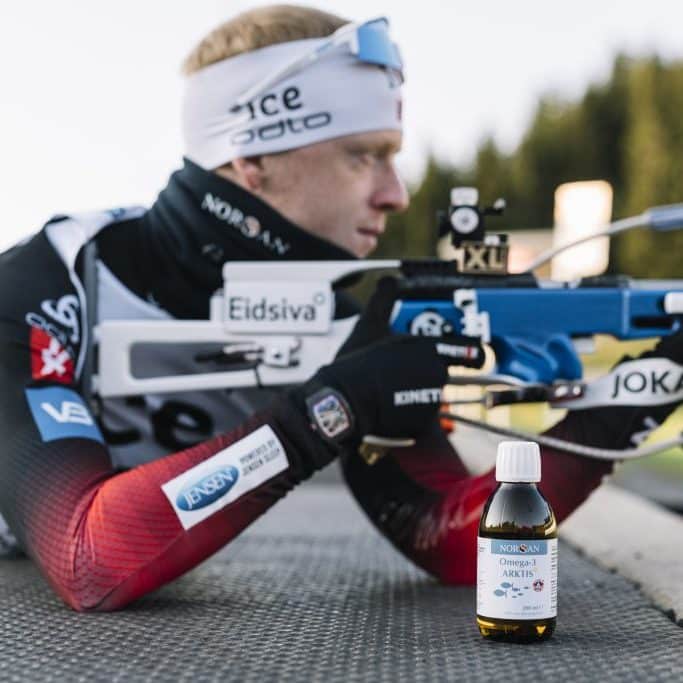POMEN omega-3
V TEKMOVALNIH ŠPORTIH
Članek z naslovom Omega -3 maščobne kisline – stopnje v tekmovalnem športu!, ki ga je napisal
dr. Clemens von Schacky in je izšel v nemškem časopisu športnih zdravnikov Sportärztezeitung,
govori o pozitivnem učinku Omega-3 maščobnih kislin v tekmovalnih športih.
V nadaljevanju smo za vas povzeli vsebino članka.
Pozitivni učinki Omega-3
na mišice, srce in sklepe
V Nemčiji in ZDA lahko pri tekmovalnih športnikih opazimo zelo nizke ravni Omega-3 maščobnih kislin. Za analizo ravni pomembnih morskih maščobnih kislin Omega-3 (EPA – eikozapentaenojska kislina in DHA – dokozaheksaenojska kislina) v rdečih krvnih celicah je bila uporabljena metoda HS-Omega-3 Index®. Medtem ko za optimalen razpon velja 8 – 11 %, so pri športnikih v povprečju izmerili precej nižji indeks.

Huda depresija
Verjetnost razvoja velike depresije je pri tekmovalnih športnikih večja v primerjavi s povprečno populacijo. Višja kot je raven omega-3 v rdečih krvnih celicah, manjša je verjetnost hude depresije. Številne metaanalize potrjujejo, da se samostojno dajanje EPA in DHA ter v kombinaciji s konvencionalno psihiatrično terapijo izkaže za učinkovito pri preprečevanju in zdravljenju hude depresije. Visoke vsebnosti maščobne kisline EPA dodatno povečajo učinek, pri čemer poudarjajo protivnetne vidike učinkovitosti. Iz tega razloga smernice zdaj začenjajo priporočati omega-3 maščobne kisline EPA in DHA pri terapevtskem zdravljenju hude depresije.
Kognitivne funkcije in poškodbe možganov pri športnikih
Travmatska poškodba možganov se pogosteje pojavi pri športih, kot sta nogomet ali ameriški nogomet. Te večinoma povzročijo strukturne poškodbe možganov, ki lahko zmanjšajo delovanje možganov. Znano je, da so kompleksne možganske funkcije in vidiki strukture možganov, kot je spomin, povezani s količino EPA in DHA v rdečih krvnih celicah. Na primer, štiritedenska študija med nogometašicami španske prve lige je pokazala, da so se učinkovitost, natančnost in reakcijski čas izboljšali, ko so jemale 3,5 g EPA in DHA na dan v primerjavi s skupino, ki je prejemala placebo.
Rezultati intervencijskih študij kognitivnih funkcij, kot so spomin, abstraktno razmišljanje in podobno kompleksne možganske funkcije, so bili prav tako pozitivni pri odmerkih nad 800 mg DHA na dan. Tako lahko sklepamo, da visoke ravni EPA in DHA koristijo kognitivnim funkcijam športnikov v športih, ki vključujejo ponavljajoče se travmatske poškodbe možganov.
Učinek Omega-3 na mišice
Različne klinične študije so preverjale učinek uživanja Omega-3 maščobnih kislin pred fizičnim naporom, ki lahko povzroči mišično bolečino. Kot so ugotovili strokovnjaki, lahko Omega-3 zmanjšajo ali celo preprečijo bolečine v mišicah. Pri tem je pomembna ugotovitev, da Omega-3 pomembno pripomorejo k odsotnosti otekanja mišic in izgube moči, ki je običajno povezana z mišično bolečino.
Po podatkih britanskih nogometnih igralcev so se podobni učinki pokazali tudi po vadbi in uživanju enkratnega odmerka Omega-3. Dokazano je tudi, da visoka vsebnost Omega-3 maščobnih kislin v telesu zmanjšuje izgubo mišic, povezanih s staranjem.
Učinek Omega-3 na srce
V primerjavi s povprečno populacijo so tekmovalni športniki izpostavljeni večjemu tveganju za nenadno srčno smrt. Nizke ravni morskih Omega-3 maščobnih kislin EPA in DHA imajo 10-krat večjo verjetnost, da povzročijo nenadno srčno smrt kot visoke ravni Omega-3.
Intervencijska študija bolnikov s srčno-žilnimi boleznimi je pokazala, da uživanje Omega-3 zmanjša nenadno srčno smrt pri bolnikih s koronarno srčno boleznijo.
Vpliv omega-3 na sklepe
Protivnetni učinki EPA in DHA so prav tako verjetno odgovorni za znatno lajšanje bolečin in drugih simptomov pri bolnikih z revmatoidnim artritisom, dokumentiranih v meta-analizah. O artritičnih in osteoartritičnih stanjih pri mačkah in psih je mogoče najti bogatejše študije. Pri obeh vrstah se lahko mobilnost in bolečina izboljšata z dajanjem dveh morskih maščobnih kislin omega-3.
Zdi se, da pri ljudeh visoke ravni EPA in DHA pospešijo tudi proces celjenja (na primer po operaciji kolena). Vendar to še ni bilo sistematično raziskano.
Viri in doziranje EPA in DHA
Skuša, losos, tuna in druge hladnovodne ribe so še posebej bogate z omega-3 maščobnimi kislinami EPA in DHA. Vendar je treba opozoriti, da so dolgoživeče plenilske ribe, kot je tun, na dnu prehranjevalne verige in tako v življenju absorbirajo veliko število težkih kovin in toksinov. Zato pogosto uživanje teh vrst rib odsvetujemo.
Medtem ko gojene ribe vsebujejo čedalje manj omega-3, saj uporabljena krma postane manjša v omega-3, se divje ujete ribe gibljejo več in tako vsebujejo manj maščob na splošno. Če želite zaužiti določeno dozo EPA in DHA na dan, je edina preostala možnost dopolnitev s pripravki iz ribjega olja z zajamčeno vsebnostjo omega-3 ali oljem rastlinskih alg kot veganska alternativa. Pri kakovostnih proizvajalcih temeljito čiščenje toksinov in drugih nečistoč poteka v okviru proizvodnega procesa.
Da bi zagotovili optimalno absorpcijo in predelavo omega-3 maščobnih kislin v telesu, je treba dodatke omega-3 vedno jemati skupaj z glavnim obrokom ali obrokom z visoko vsebnostjo maščob. Ta pristop aktivira prebavo maščob in poveča biološko uporabnost. Za dvig indeksa omega-3 v ciljno območje 8-11 % je običajno potrebnih največ 5 g omega-3 (EPA in DHA) na dan.
Zaključek
Povprečni indeks omega-3 pri športnikih je precej pod ciljnim razponom 8-11 %. Posledica tega je krajša pričakovana življenjska doba – tudi zaradi povečane verjetnosti nenadne srčne smrti –, ampak tudi zmanjšano delovanje mišic, srčno-žilnega sistema, možganov in drugih organov, ki so v tekmovalnem športu še posebej obremenjeni.

Z vzdrževanjem dovolj visoke ravni omega-3 lahko športniki preprečijo resne bolezni, kot sta nenadna srčna smrt ali huda depresija. Poleg tega je mogoče optimizirati delovanje mišic in možganov ter upočasniti proces staranja obeh organov.
Jemanje do 5 g EPA in DHA na dan za zvišanje indeksa omega-3 proti ciljnemu območju je varno in ga bolniki dobro prenašajo. Indeks je treba ponoviti s pomočjo nove analize maščobnih kislin po približno 3 do 4 mesecih in po potrebi prilagoditi odmerek.
Prof. dr. Clemens von Schacky je bil glavni zdravnik kardiologije v “Medical Park Sankt Hubertus” in je vodja preventivne kardiologije na Univerzi v Münchnu LMU. Je strokovnjak na področju kardiologije in je v strokovnih krogih neposredno povezan s področjem omega-3 maščobnih kislin.
Če vas zanima izvirni članek “Omega-3 maščobne kisline – Stopnje v tekmovalnem športu!” dr. Clemensa von Schackyja nas kontaktirajte na e-mail info@norsan.si in z veseljem vam bomo poslali članek.
